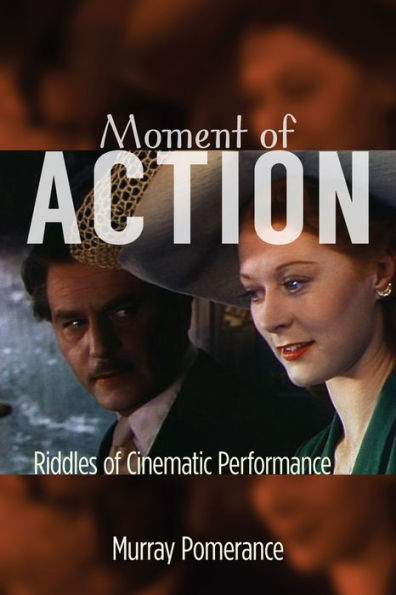There are hundreds of biographies of filmstars and dozens of scholarly works on acting in general. But what about the ephemeral yet indelible moments when, for a brief scene or even just a single shot, an actor’s performance triggers a visceral response in the viewer?
Moment of Action delves into the mysteries of screen performance, revealing both the acting techniques and the technical apparatuses that coalesce in an instant of cinematic alchemy to create movie gold. Considering a range of acting styles while examining films as varied as Bringing Up Baby, Psycho, The Red Shoes, Godzilla, and The Bourne Identity, Murray Pomerance traces the common dynamics that work to structure the complex relationship between the act of cinematic performance and its eventual perception.
Mining the spaces where subjective and objective analyses merge, Pomerance offers both a deeply personal account of film viewership and a detailed examination of the intuitive gestures, orchestrated movements, and backstage maneuvers that go into creating those phenomenal moments onscreen. Moment of Action takes us on an innovative exploration of the nexus at which the actor’s keen skills spark and kindle the audience’s receptive energies.
"1123057388"
Moment of Action delves into the mysteries of screen performance, revealing both the acting techniques and the technical apparatuses that coalesce in an instant of cinematic alchemy to create movie gold. Considering a range of acting styles while examining films as varied as Bringing Up Baby, Psycho, The Red Shoes, Godzilla, and The Bourne Identity, Murray Pomerance traces the common dynamics that work to structure the complex relationship between the act of cinematic performance and its eventual perception.
Mining the spaces where subjective and objective analyses merge, Pomerance offers both a deeply personal account of film viewership and a detailed examination of the intuitive gestures, orchestrated movements, and backstage maneuvers that go into creating those phenomenal moments onscreen. Moment of Action takes us on an innovative exploration of the nexus at which the actor’s keen skills spark and kindle the audience’s receptive energies.
Moment of Action: Riddles of Cinematic Performance
There are hundreds of biographies of filmstars and dozens of scholarly works on acting in general. But what about the ephemeral yet indelible moments when, for a brief scene or even just a single shot, an actor’s performance triggers a visceral response in the viewer?
Moment of Action delves into the mysteries of screen performance, revealing both the acting techniques and the technical apparatuses that coalesce in an instant of cinematic alchemy to create movie gold. Considering a range of acting styles while examining films as varied as Bringing Up Baby, Psycho, The Red Shoes, Godzilla, and The Bourne Identity, Murray Pomerance traces the common dynamics that work to structure the complex relationship between the act of cinematic performance and its eventual perception.
Mining the spaces where subjective and objective analyses merge, Pomerance offers both a deeply personal account of film viewership and a detailed examination of the intuitive gestures, orchestrated movements, and backstage maneuvers that go into creating those phenomenal moments onscreen. Moment of Action takes us on an innovative exploration of the nexus at which the actor’s keen skills spark and kindle the audience’s receptive energies.
Moment of Action delves into the mysteries of screen performance, revealing both the acting techniques and the technical apparatuses that coalesce in an instant of cinematic alchemy to create movie gold. Considering a range of acting styles while examining films as varied as Bringing Up Baby, Psycho, The Red Shoes, Godzilla, and The Bourne Identity, Murray Pomerance traces the common dynamics that work to structure the complex relationship between the act of cinematic performance and its eventual perception.
Mining the spaces where subjective and objective analyses merge, Pomerance offers both a deeply personal account of film viewership and a detailed examination of the intuitive gestures, orchestrated movements, and backstage maneuvers that go into creating those phenomenal moments onscreen. Moment of Action takes us on an innovative exploration of the nexus at which the actor’s keen skills spark and kindle the audience’s receptive energies.
37.95
In Stock
5
1

Moment of Action: Riddles of Cinematic Performance
204
Moment of Action: Riddles of Cinematic Performance
204Paperback(None ed.)
$37.95
37.95
In Stock

Product Details
| ISBN-13: | 9780813564951 |
|---|---|
| Publisher: | Rutgers University Press |
| Publication date: | 05/09/2016 |
| Edition description: | None ed. |
| Pages: | 204 |
| Product dimensions: | 5.90(w) x 8.90(h) x 0.60(d) |
| Age Range: | 16 - 18 Years |
About the Author
From the B&N Reads Blog
